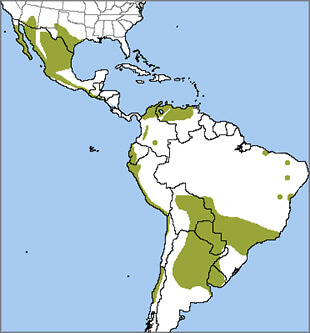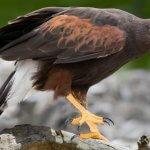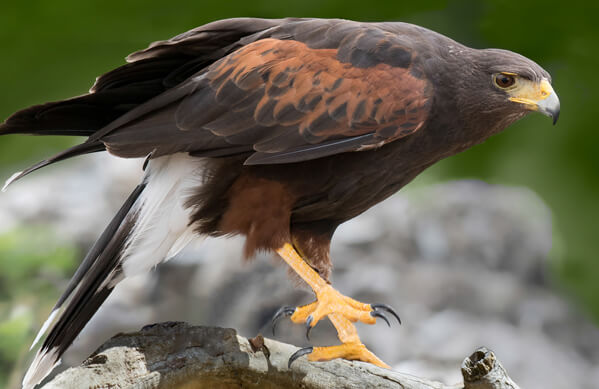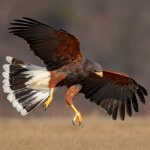About the Harris's Hawk
The long-legged Harris's Hawk, once known as the Bay-winged Hawk or One-banded Buzzard, was named by John James Audubon for fellow naturalist Edward Harris. It shares its genus, Parabuteo, with just one other species, and is only distantly related to other North American raptors such as the Swainson's Hawk.
Back-stacking Behavior
One of the species' interesting behaviors is called "back stacking," when up to four Harris's Hawks stand on top of each other while perched. Back stacking is actually a sensible adaptation to the Harris's Hawk's wide-open habitats. The hawk on top gets a better view for hunting, making up for the lack of elevated perches in the landscape.
This behavior also illustrates the species' sociable nature, an un-hawk-like trait that makes it easy to train for falconry and educational programs. One of the oldest known Harris's Hawks, a 33-year-old captive bird named Cheyenne, serves as an educational ambassador for her species at the Freedom Center for Wildlife, Inc. in New Jersey.
Songs and Sounds
(Audio by Robin Carter, XC1325. Accessible at www.xeno-canto.org/1325)
Breeding and Feeding
All in the Family
Harris's Hawks nest in social units of up to seven individuals. Immature birds from previous broods and some unrelated birds help defend the territory and also assist in hunts. This type of cooperative system occurs in other bird species ranging from Green Jay to Red-cockaded Woodpecker.
The female Harris's Hawk builds a large stick nest in a saguaro cactus or tall tree, sometimes re-using the nest in successive years. When food is plentiful, females may lay a second and even a third clutch.
Winged Wolf Pack
This unusual raptor hunts in cooperative groups of two to six birds, like a wolf pack with wings. Groups of Harris's Hawks hunt low over the ground, with one lead bird scouting out potential prey, including small mammals, birds, lizards, and large insects.
The birds take turns chasing their quarry to exhaustion; if the targeted prey hides, one hawk will flush it out while the rest wait to pounce. The entire group may share larger prey items.
This cooperative hunting behavior increases the birds' hunting efficiency and prey capture rate, ensuring higher survival rates in the Harris's Hawk's often inhospitable environment.

Region and Range

Harris's Hawk is found from the southwestern United States through Mexico and in appropriate habitats as far south as Argentina.
The species is resident throughout its range, occupying and defending the same territory year-round. In recent years, Harris's Hawks have become more common in urban and suburban areas of Arizona as the Sonoran Desert is increasingly developed.
Conservation
Harris's Hawks face many of the same man-made challenges as other birds of prey, such as the California Condor and Golden Eagle. Habitat loss is an ever-present threat, and electrocution on power lines, poisoning, and collisions with vehicles pose additional dangers.

Help support ABC's conservation mission!
ABC's conservation advocacy programs continue work to reduce or remove some of the challenges faced by Harris's Hawks throughout the Americas. Our BirdScapes approach to conservation guides restoration of key habitats, including desert riparian corridors used by Harris's Hawks and other priority species, such as the western population of Yellow-billed Cuckoo.
A 2018 study showed that Harris's Hawks and other raptors have excellent color vision — in certain situations even better than humans. While this attribute helps the birds detect and capture prey, it may also help researchers implement modifications to prevent collisions with wind turbines and power lines.
Get Involved
Policies enacted by the U.S. Congress and federal agencies, such as the U.S. Fish and Wildlife Service, have a huge impact on migratory birds. You can help shape these rules for the better by telling lawmakers to prioritize birds, bird habitat, and bird-friendly measures. To get started, visit ABC's Action Center.
Living a bird-friendly life can have an immediate impact on migratory birds in the United States. Doing so can be as easy as adding native plants to your garden, avoiding pesticides, and keeping cats indoors. To learn more, visit our Bird-Friendly Life page.
American Bird Conservancy and our Migratory Bird Joint Venture partners have improved conservation management on more than 6.4 million acres of U.S. bird habitat — an area larger than the state of Maryland — over the last ten years. That's not all: With the help of international partners, we've established a network of more than 100 areas of priority bird habitat across the Americas, helping to ensure that birds' needs are met during all stages of their lifecycles. These are monumental undertakings, requiring the support of many, and you can help by making a gift today.




















































